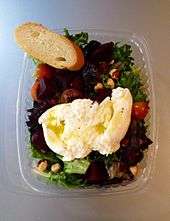Burrata
Burrata (Italian pronunciation: [burˈrata]) is an Italian cow milk cheese (occasionally buffalo milk) made from mozzarella and cream.[1] The outer shell is solid mozzarella, while the inside contains stracciatella and cream, giving it an unusual, soft texture. It is typical of Apulia.
| Burrata | |
|---|---|
 | |
| Country of origin | Italy |
| Region | Apulia |
| Town | Andria |
| Source of milk | Cows |
It is usually served fresh and at room temperature.
History
Burrata is a typical product of Murgia in the south of Italy. It is produced from cow's milk, rennet, and cream. Burrata may have origins dating back to about 1900[2] on the Bianchini farm in the city of Andria within Murgia, an area in the Apulian region. More recent records have shown that Lorenzo Bianchini of the Piana Padura farm first developed the product in 1956.[3]
In the 1950s, it became more widely available after some local cheese factories began producing it and it can be a useful way of using up the ritagli ("scraps" or "rags") of mozzarella.
In November 2016 "Burrata di Andria" became a Protected geographical indication (PGI) product.[4] [5]
Established as an artisanal cheese, burrata maintained its premium-product status even after it began to be made commercially in factories throughout Apulia.[6]
Burrata is also produced in the United States, particularly in artisanal cheese shops in cities on the East Coast with historically large populations of Italian Americans.[7] Nevertheless, for the original "Burrata di Andria" (PGI) all operations from the processing of the raw materials up to the production of the finished product must take place in the defined geographical area of the Region of Apulia.[8]
Production

Burrata starts out much like mozzarella and many other cheeses, with rennet used to curdle the warm milk. But then, unlike other cheeses, fresh mozzarella curds are plunged into hot whey or lightly salted water, kneaded, and pulled to develop the familiar stretchy strings (pasta filata), then shaped in whatever form is desired.
When making burrata, the still-hot cheese is formed into a pouch, which is then filled with scraps of leftover mozzarella and topped off with fresh cream before closing. The finished burrata is traditionally wrapped in the leaves of asphodel, tied to form a little brioche-like topknot, and moistened with a little whey. The asphodel leaves should still be green when the cheese is served to indicate the cheese's freshness.[9] More recently, the cheese is often sold in a plastic bag or container.
Serving suggestions
When the burrata is sliced open, a spurt of thickened cream flows out. The cheese has a rich, buttery flavor and retains its fresh milkiness. It is best when eaten within 24 hours and is considered past its prime after 48 hours. Thanks to its flavor and differing textures inside and outside, it goes well with salad,[10] prosciutto crudo, crusty bread, fresh tomatoes with olive oil, cracked black pepper, or pasta.
References
- Contini, M.; Contini, P. (2012). Valvona & Crolla: A Year at an Italian Table. Ebury Publishing. p. 195. ISBN 978-1-4481-4783-0. Retrieved 11 December 2017.
- "Burrata, la regina dei formaggi". Archived from the original on 16 April 2008. Retrieved 30 March 2011.
- "LA BURRATA DI ANDRIA. LA PRODUZIONE CASEARIA PUGLIESE IN TAVOLA A ROMA" (in Italian). ciclostazionefrattini.it. 13 July 2017.
- "Burrata di Andria IGP :: FOOD :: Italia". Qualivita :: DOP IGP STG. Retrieved 30 July 2018.
- "Official Journal of the European Union: registration of "Burrata di Andria" (PGI)". Retrieved 7 May 2019.
- Karen Hochman (October 2007). "Burrata Cheese". Cheese-Butter-Yoghurt Product Reviews. The Nibble. Retrieved 17 March 2011.
- Darlington, Tenaya. "Cheese of the Month: Claudio's Mozzarella". Grid Philly. Retrieved 26 August 2015.
- "Official Journal of the European Union: "Burrata di Andria" (PGI)". Retrieved 7 May 2019.
- Roberts, Genevieve (2 March 2011). "Burrata: Britain's new Big cheese". The Independent. Retrieved 7 September 2013.
- Nicole Buergers (4 July 2011). "What is Burrata?". The Queso Queen (cheese blog). Archived from the original on 27 March 2012. Retrieved 19 July 2011.